HP Stream 7 Review: A $119 Windows Tablet
by Brandon Chester on December 19, 2014 8:00 AM ESTDisplay
The display is one of the most important aspects of a device, as it's the portal for interaction between the user and the software. Unfortunately, with inexpensive devices like the Stream 7, the display is often the first thing to be put on the chopping block. It's simply very difficult to put a high quality panel in a low cost device and make money selling it. That being said, HP has actually attempted to put a decent panel in the Stream 7 considering its price target.
Like I stated before, many other tablets at this size and price point either opt for a TN panel, or they reduce the resolution to 1024x600 or even go lower to 800x480, which is borderline unusable. HP has put a 1280x800 IPS panel in the Stream 7, which is fairly good considering that two years ago most Android tablets of any size shipped with that same resolution. The glass is highly reflective, and this is coupled with the fact that the display isn't laminated. There's also some light bleed at the bottom, but at $119 I can excuse this.
Of course, specs that you read on paper like size and resolution only tell part of the story. Color accuracy, brightness, and contrast all have an impact on overall display quality, and to measure these we use SpectraCal's CalMAN 5 software along with X-Rite's i1Pro 2 spectrophotometer and i1Display Pro colorimeter.
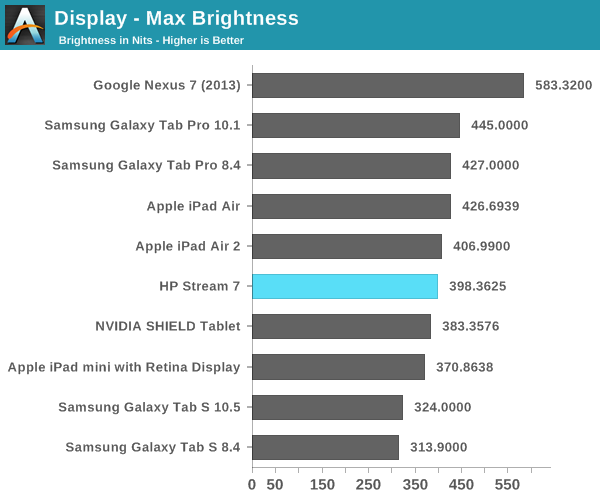
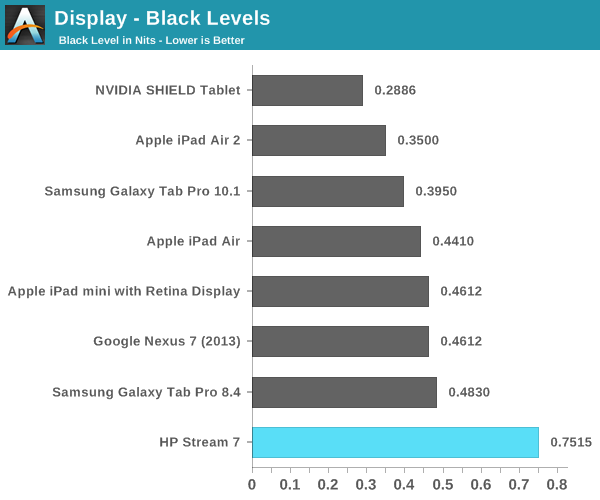
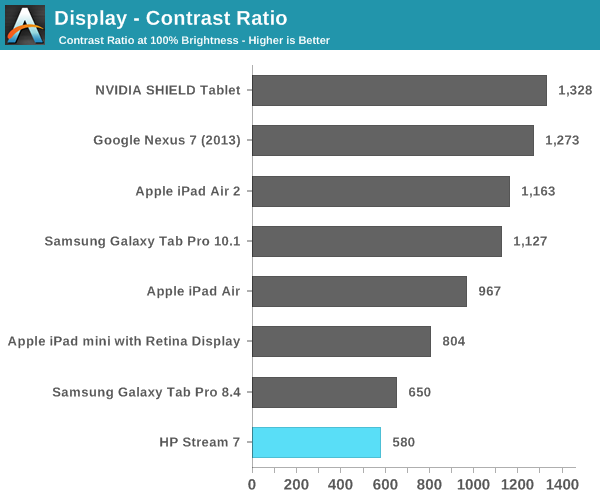
As you can see, the brightness of the Stream 7 is competitive with other tablets. Unfortunately, the black levels are just too high, which in turn leads to a very low contrast ratio. It should be noted that these measurements were achieved by disabling Intel's Display Power Saving Technology (DPST) feature, which causes dynamic brightness and contrast depending on the image displayed on the screen. While some other devices do this to some degree, DPST ended up reducing max brightness measurements by nearly 100nits, and the constantly changing brightness played havoc with measurements during analysis and calibration.
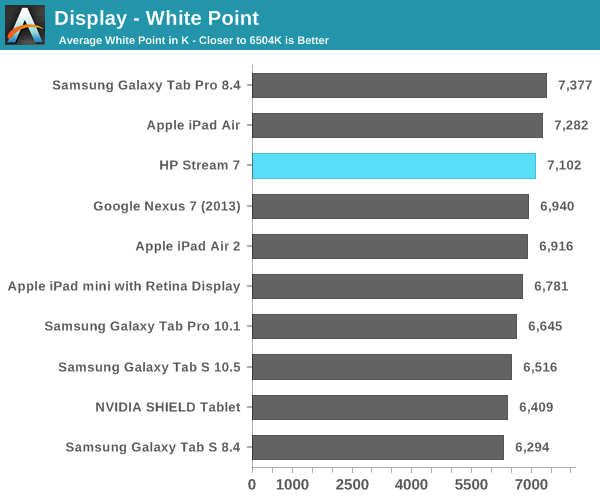
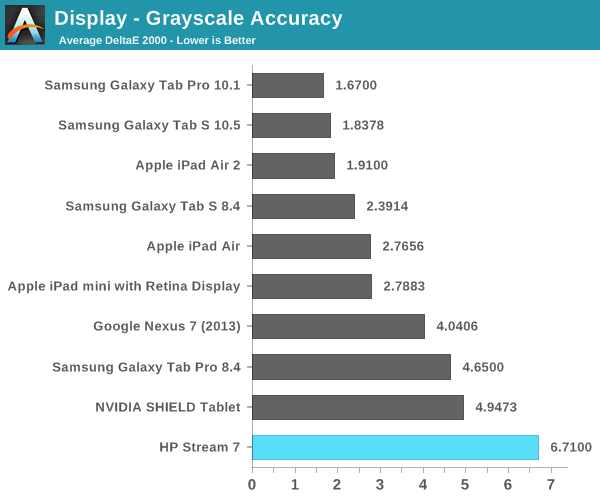
In the grayscale we see a shift toward blue, with the red steadily dropping off as brightness increases. This leads to the grayscale performance being some of the worst we have tested, but at $119 there's really no room for HP to do any calibration to the display panels at the factory.
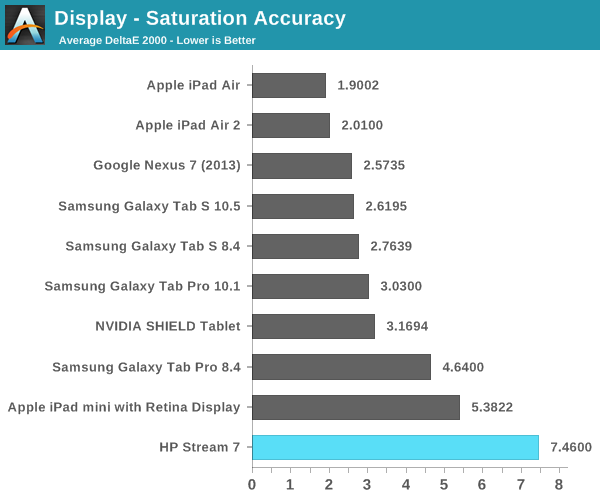
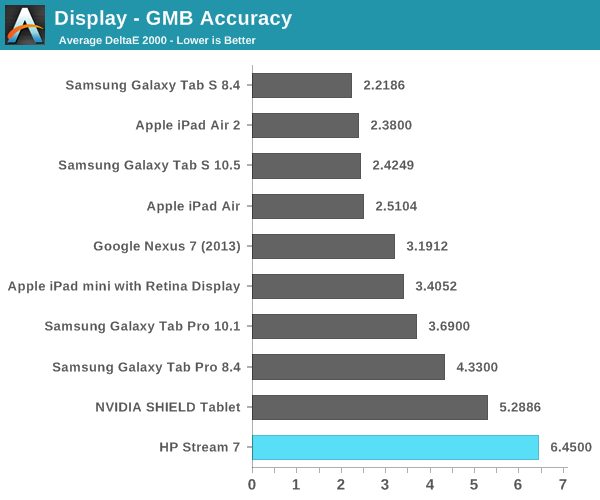
As with the grayscale test, we see poor performance in the saturation sweep. The display does not cover all of sRGB, and we see that for each 20% increment in the saturation sweep, the red, blue, and magenta saturations are all 20% lower than they should be and just generally inaccurate. The poor grayscale and saturation performance leads to a high average error in the color checker test, which means that the Stream 7 is not going to be able to accurately reproduce colors.
Again, this is to be expected with a device of this price point. It does however provide a good example of how the idea that IPS technology correlates with color accuracy is a misconception. With the prices of IPS displays being driven into TN territory by affordable eIPS panels, having an IPS display really just guarantees better viewing angles than a TN panel, nothing more.
One last thing to note about the display which does not show up in any measurements is that it is a 6bit + AFRC eIPS panel. This is not uncommon even in desktop monitors that cost as much as $400, but it does mean that there is noticeable posterization compared to a display with actual 8-bit color depth for red, green, and blue. This is not helped by the fact that Internet Explorer is not smart about displaying images; it doesn't seem to apply the same dithering that Chrome and Firefox do to mask color banding.
Calibration
Fortunately, the HP Stream 7 runs Windows. Unlike Android and iOS, Windows has color management capabilities. This allows us to calibrate the Stream 7 in an attempt to fix some of the issues with the display. We are working with a narrow gamut panel here so we aren't going to see much improvement to the saturation test, but we can certainly improve grayscale and color accuracy within the display's gamut.
After creating and applying an ICC profile created by CalMAN, we see a dramatic improvement in grayscale performance on the Stream 7. Gone is the shift toward blue, with a white point of 6595K that is very close to standard. Shades of grey are now accurate enough that you would be unable to see a difference from a reference monitor. These improvements unfortunately are accompanied by a significant drop in luminance, with a max display brightness of 308.5 nits after calibration.
We see slight improvement in the saturation sweep, but it's still nothing exceptional and unfortunately bound by the display's small color gamut. However, there's a significant improvement in the color checker test, although much of this can be attributed to the improvements in grayscale. There is an overall improvement in the accuracy of colors, but a few colors actually have a greater error after calibration than before. The biggest improvements are to mixtures of green and red, which has a significant impact on photos and videos by improving the accuracy of skin tones.
Overall, I'm surprised that the Stream 7 was able to be improved this much. It's certainly not perfect after calibration but it's much better. Unfortunately, I don't think many buyers of the Stream 7 are going to have the necessary equipment to calibrate the display properly, so it's more of an academic exercise.


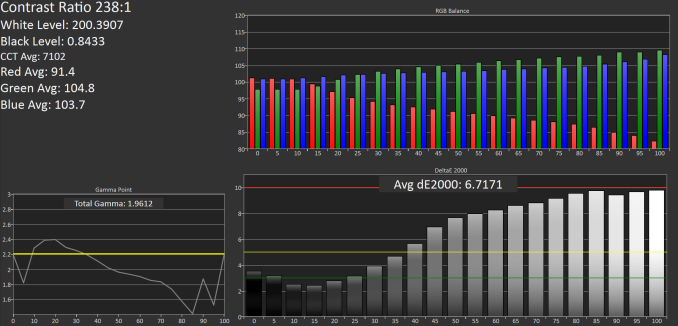

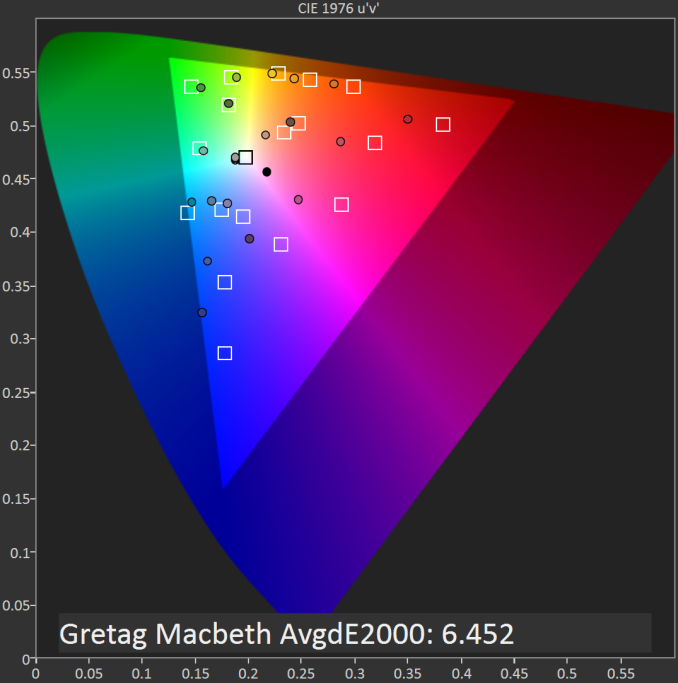
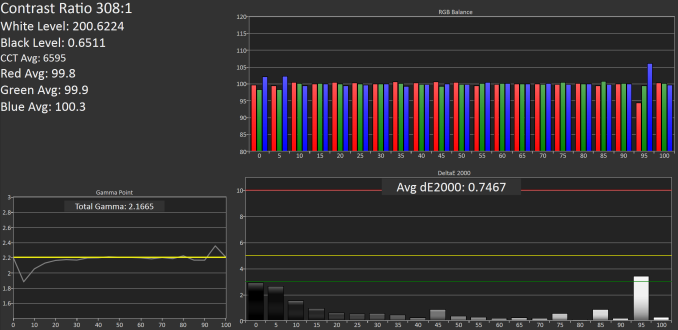
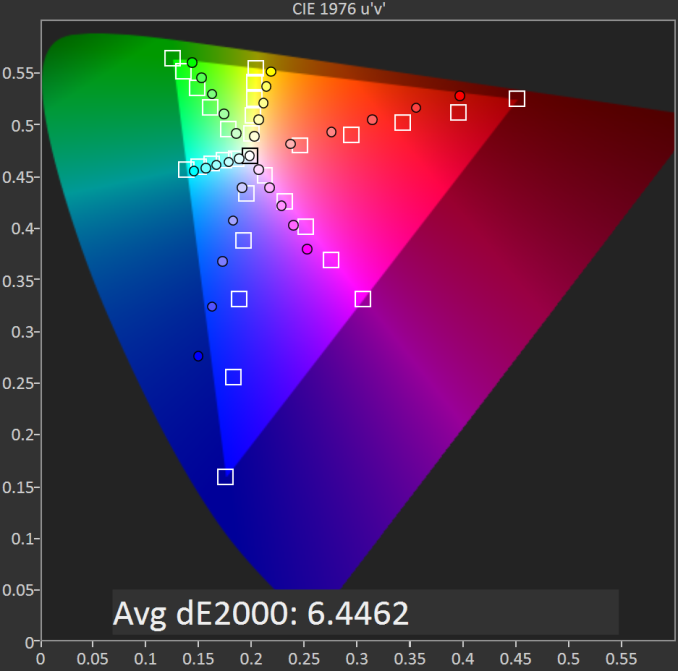
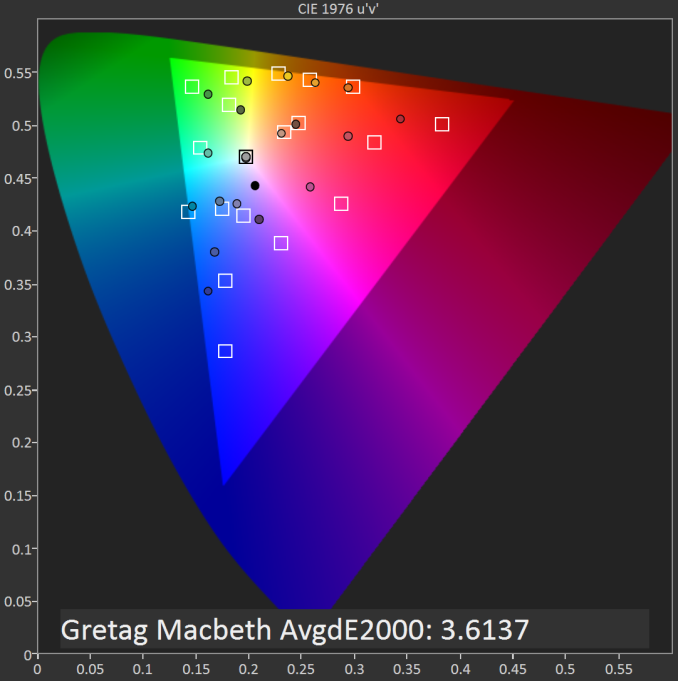








157 Comments
View All Comments
rootheday3 - Saturday, December 20, 2014 - link
Brandon-You say on the Display page of the review:
"It should be noted that these measurements were achieved by disabling Intel's Display Power Saving Technology (DPST) feature, which causes dynamic brightness and contrast depending on the image displayed on the screen. While some other devices do this to some degree, DPST ended up reducing max brightness measurements by nearly 100nits, and the constantly changing brightness played havoc with measurements during analysis and calibration."
and also on the battery life page:
"It's likely that enabling Intel's DPST will improve these results, but all that really means is that dimming the display below our 200nits standard will improve battery life."
DPST shouldn't reduce overall brightness - the algorithm it uses is designed to detect dark scenes and change the panel gamma curve to let more light through while reducing the backlight intensity to match. If working properly this can save a lot of backlight power on scenes that have low luminance values and moderate contrast to start with (e.g. movie watching). Normally there should be no noticeable difference in overall brightness of the image (though there may be a second or two of visible modulation if the image suddenly changes from bright to dark or vice versa). If you are seeing drops of 100 or 200 nits brightness when DPST is active, something isn't right.
For what its worth, other devices use techniques (called CABC - content adaptive backlight control) that do the same things as DPST - they generally just don't give you control over it the way that Intel's control panel does.
Are you 100% confident that the visual issues and brightness issues you are describing are isolated to this device or to Intel DPST in general and that other mobile devices don't have similar dimming going on?
Any possibility thaty you are conflating DPST vs Automatic Display Brightness (ADB) based on ambient light sensor detected brightness variations in the room?
Backlight is a huge contributor to platform power in tablets and other very low power mobile devices -If you only disable DPST on Intel platforms but don't disable CABC on other platforms, your low battery life results are perhaps not fair...
Note also that the Intel control panel offers an aggressiveness slider for DPST - can you reduce the aggressiveness value and see if that makes it better visually?
Brandon Chester - Saturday, December 20, 2014 - link
Some other devices do it in the video test, but not in the web browsing test. You can see the brightness of the Stream 7 decrease when you load a very white web page, and it goes back up when you return to somewhere like the Start Screen. This doesn't happen on an iPad. You can see in our Asus UX21 review that DPST does reduce the brightness when showing an all white screen, so I don't think there's anything wrong with my statement that DPST was reducing max brightness in our test.Oh and no, it wasn't ADB, I disabled that right when I set up the tablet.
Laststop311 - Saturday, December 20, 2014 - link
Smaller battery than note 4 phone thats only 5.7" is worriesome. This tablet could of been really good if they just upped the ram to 3GB and upped the battery to 4000+mah. I think it would of sold more if they raised the price an extr 25 for the extra 2GB of ram and an extra 15 for the extra 1000mah of battery. Doesn;t a tablet like that for 159 sound a lot better than the current one for 119Laststop311 - Saturday, December 20, 2014 - link
Wouldn't mind seeing a 64GB option for 30-50 more as wellados_cz - Sunday, December 21, 2014 - link
They can't up the ram without changing the CPU which in turn would increase the price further more, the atom Z3735G is limited to maximum of 1GB of ram. But the ram is not problem on this device, I hard-set swap file to 2GB on my Linx 7 (same atom) and it runs just great.Roy2001 - Saturday, December 20, 2014 - link
I have stream 8, Intel Soc performs very well, but OS is not so good.andrewaggb - Sunday, December 21, 2014 - link
I have a 64gb miix 2 8" windows tablet. Picked it up used/cheap. It's pretty decent, but the quantity of windows updates are a bit ridiculous. The app selection is much different, but there's plenty of games and apps my kids like on it. My daughter probably prefers it to the ipad, my son definitely prefers the ipad.Desktop apps suck on it, they run fine, but the screen is too small in my opinion.
Performance wise I think it runs fine.
Battery life is ok, but not as good as an ipad.
I imagine the stream 7 is very similar. For $100 it's probably a great deal. You also get full flash support, which I use for some streaming applications.
spdfreak - Sunday, December 21, 2014 - link
I wonder if these are basically the same as the Winbook Tablets that MicroCenter sells. The MC 7in tablet is 60.00 in today's ad. The 8in with 2GB Ram is 140.00.HD IPS LCD 7" 1280x800 Display
Intel BayTrail-T Z3735G 1.33GHz Quad-Core CPU
1GB RAM & 16 Flash Storage
Windows 8.1 OS
Expandable up to 64GB via microSD Card
The WinBook 7" TW700 Tablet has 16GB of integrated storage, which can be expanded via microSD Card. Includes 1 year subscription for Office 365 Personal.
darkich - Sunday, December 21, 2014 - link
Good review, and I agree that spec wise this is probably the best tablet for the price.But I would rather recommend buying an used Android tablet for this price.
For 110$ I got an aluminum 8“ IPS (excellent Samsung panel) 800p quad core 3G tablet with 2+5Mpix cameras, even radio, GSM and GPS. Slim, stylish and just 340g of weight. Still 20 months of warranty and in pristine condition.
Finally, for a tablet use case Android is definitely a much better choice than Windows.
jkauff - Sunday, December 21, 2014 - link
For less than a hundred bucks I can play movies on a handheld device using MPC-HC and madVR on default settings. Pretty cool. BTW, I fixed my headphone jack with a shot of compressed air and a bit of contact cleaner. It wasn't defective, just dirty.